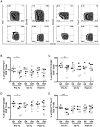CD127 expression, exhaustion status and antigen specific proliferation predict sustained virologic response to IFN in HCV/HIV co-infected individuals
- PMID: 25007250
- PMCID: PMC4090061
- DOI: 10.1371/journal.pone.0101441
CD127 expression, exhaustion status and antigen specific proliferation predict sustained virologic response to IFN in HCV/HIV co-infected individuals
Abstract
Hepatitis C virus (HCV) infection is a major cause of morbidity and mortality in the HIV co-infected population. Interferon-alpha (IFN-α) remains a major component of anti-HCV therapy despite its deleterious effects on the immune system. Furthermore, IFN-α was recently shown to diminish the size of the latent HIV reservoir. The objectives of this study were to monitor the impact of IFN-α on T cell phenotype and proliferation of HIV and HCV-specific T cells during IFN therapy, and to identify immune markers that can predict the response to IFN in HICV/HIV co-infected patients. We performed longitudinal analyses of T cell numbers, phenotype and function in co-infected patients undergoing IFN-α therapy with different outcomes including IFN-α non-responders (NR) (n = 9) and patients who achieved sustained virologic response (SVR) (n = 19). We examined the expression of activation (CD38, HLA-DR), functional (CD127) and exhaustion markers (PD1, Tim-3, CD160 and CD244) on total CD4 and CD8 T cells before, during and after therapy. In addition, we examined the HIV- and HCV-specific proliferative responses against HIV-p24 and HCV-NS3 proteins. Frequencies of CD127+ CD4 T cells were higher in SVR than in NR patients at baseline. An increase in CD127 expression on CD8 T cells was observed after IFN-α therapy in all patients. In addition, CD8 T cells from NR patients expressed a higher exhaustion status at baseline. Finally, SVR patients exhibited higher proliferative response against both HIV and HCV antigens at baseline. Altogether, SVR correlated with higher expression of CD127, lower T cell exhaustion status and better HIV and HCV proliferative responses at baseline. Such factors might be used as non-invasive methods to predict the success of IFN-based therapies in co-infected individuals.
Conflict of interest statement
Figures




Similar articles
-
Circulating sCD14 is associated with virological response to pegylated-interferon-alpha/ribavirin treatment in HIV/HCV co-infected patients.PLoS One. 2012;7(2):e32028. doi: 10.1371/journal.pone.0032028. Epub 2012 Feb 21. PLoS One. 2012. PMID: 22363790 Free PMC article.
-
Low levels of microbial translocation marker LBP are associated with sustained viral response after anti-HCV treatment in HIV-1/HCV co-infected patients.PLoS One. 2015 Mar 18;10(3):e0118643. doi: 10.1371/journal.pone.0118643. eCollection 2015. PLoS One. 2015. PMID: 25785448 Free PMC article.
-
Behavior of soluble HLA-A, -B, -C and HLA-G molecules in patients with chronic hepatitis C virus infection undergoing pegylated interferon-α and ribavirin treatment: potential role as markers of response to antiviral therapy.Clin Exp Med. 2017 Feb;17(1):93-100. doi: 10.1007/s10238-015-0399-5. Epub 2015 Nov 14. Clin Exp Med. 2017. PMID: 26567007
-
Interferon-α Subtypes As an Adjunct Therapeutic Approach for Human Immunodeficiency Virus Functional Cure.Front Immunol. 2018 Feb 22;9:299. doi: 10.3389/fimmu.2018.00299. eCollection 2018. Front Immunol. 2018. PMID: 29520278 Free PMC article. Review.
-
Cognitive consequences of a sustained monocyte type 1 IFN response in HIV-1 infection.Curr HIV Res. 2014;12(2):77-84. doi: 10.2174/1570162x12666140526113544. Curr HIV Res. 2014. PMID: 24862334 Free PMC article. Review.
Cited by
-
Specific CD8(+) T cell response immunotherapy for hepatocellular carcinoma and viral hepatitis.World J Gastroenterol. 2016 Jul 28;22(28):6469-83. doi: 10.3748/wjg.v22.i28.6469. World J Gastroenterol. 2016. PMID: 27605882 Free PMC article. Review.
-
Gamma-Delta T-Cell Phenotype and Function in DAA-Treated HIV-HCV Co-Infected and HCV-Mono-Infected Subjects.Viruses. 2022 Jul 22;14(8):1594. doi: 10.3390/v14081594. Viruses. 2022. PMID: 35893661 Free PMC article.
-
Coinhibitory Receptor Expression and Immune Checkpoint Blockade: Maintaining a Balance in CD8+ T Cell Responses to Chronic Viral Infections and Cancer.Front Immunol. 2017 Sep 29;8:1215. doi: 10.3389/fimmu.2017.01215. eCollection 2017. Front Immunol. 2017. PMID: 29033936 Free PMC article. Review.
-
Future of anti-PD-1/PD-L1 applications: Combinations with other therapeutic regimens.Chin J Cancer Res. 2018 Apr;30(2):157-172. doi: 10.21147/j.issn.1000-9604.2018.02.01. Chin J Cancer Res. 2018. PMID: 29861603 Free PMC article.
-
Pulmonary Immune Dysregulation and Viral Persistence During HIV Infection.Front Immunol. 2022 Jan 4;12:808722. doi: 10.3389/fimmu.2021.808722. eCollection 2021. Front Immunol. 2022. PMID: 35058937 Free PMC article. Review.
References
-
- Joshi D, O'Grady J, Dieterich D, Gazzard B, Agarwal K (2011) Increasing burden of liver disease in patients with HIV infection. Lancet 377: 1198–1209. - PubMed
-
- Graham CS, Baden LR, Yu E, Mrus JM, Carnie J, et al. (2001) Influence of human immunodeficiency virus infection on the course of hepatitis C virus infection: a meta-analysis. Clin Infect Dis 33: 562–569. - PubMed
-
- Netski DM, Mosbruger T, Astemborski J, Mehta SH, Thomas DL, et al. (2007) CD4+ T cell-dependent reduction in hepatitis C virus-specific humoral immune responses after HIV infection. J Infect Dis 195: 857–863. - PubMed
Publication types
MeSH terms
Substances
Grants and funding
LinkOut - more resources
Full Text Sources
Other Literature Sources
Medical
Research Materials

